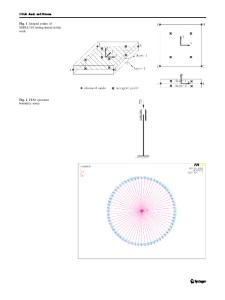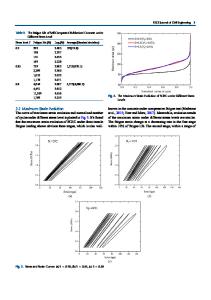Experimental Study on the Behavior of Fire Resistance of Welded Hollow Spherical Joint under Compression
- PDF / 2,061,690 Bytes
- 9 Pages / 595 x 786 pts Page_size
- 60 Downloads / 363 Views
pISSN 1226-7988, eISSN 1976-3808 www.springer.com/12205
DOI 10.1007/s12205-020-2324-z
Structural Engineering
Experimental Study on the Behavior of Fire Resistance of Welded Hollow Spherical Joint under Compression Bingsheng Huanga, Yiwei Zhanga, Ranyang Zhanga, and Fang Yanga College of Civil Engineering, Nanjing Tech University, Nanjing 211816, China
a
ARTICLE HISTORY
ABSTRACT
Received 15 December 2019 Revised 1st 12 February 2020 Revised 2nd 12 April 2020 Accepted 22 July 2020 Published Online 9 October 2020
Through the transient test on two welded hollow spherical joints subjected to compression under fire, the temperature distribution, displacement characteristics, failure mode and ultimate fire resistance time of the joint under different load ratios were obtained under standard fire. The three-dimensional finite element model of welded hollow spherical joints was established, and the performance of the joints subjected to compression under fire was analyzed. Compared with the test results, the correctness of finite element simulation analysis was verified. The results showed that during the heating process, the surface temperature of the sphere inside the steel pipe is the lowest. The surface temperature of the sphere is low at the intersection with the steel tube and is highest at the middle-latitude of the sphere. The surface temperature of sphere is lower than ISO-834 standard heating curve. Failure mode of axially compressed welded hollow spherical joints under fire is concave failure. Failure position is at the sphere connected with the steel pipe. Failure process is short. Fire resistance time of load-ratio 0.35 specimen is more than 20% longer than that of load-ratio 0.6 specimen. The critical temperature of the current fire protection code is smaller than the results of the finite element.
KEYWORDS Welded hollow spherical joint Fire Transient test Compression Temperature field Fire resistance time
1. Introduction Fire is one of the disasters that endanger the safety of buildings. Fire will cause the structure to be exposed to high temperature, and the strength and modulus of elasticity of steel will decrease rapidly at high temperature (Ou and Cao, 2006). Welded hollow spherical joints are widely used as the main node form in space grid structures. The load bearing capacity of the welded hollow spherical joints decreases with the increase of temperature in the fire environment, which may lead to the collapse of the whole grid structure. This will cause serious casualties and property losses, because spatial grid structure is generally used in public buildings with dense population. There are many researches on the whole grid structure at high temperature (Bai et al., 2011; Wang et al., 2018). As a part of the grid structure, the research on welded hollow spherical joints at high temperature is very important. At present, there are many studies on the mechanical properties of welded hollow spherical joints at room temperature (Han et al., 2003; Han and Liu, 2004; Xue et al., 2009; Ji et al.,
Data Loading...











